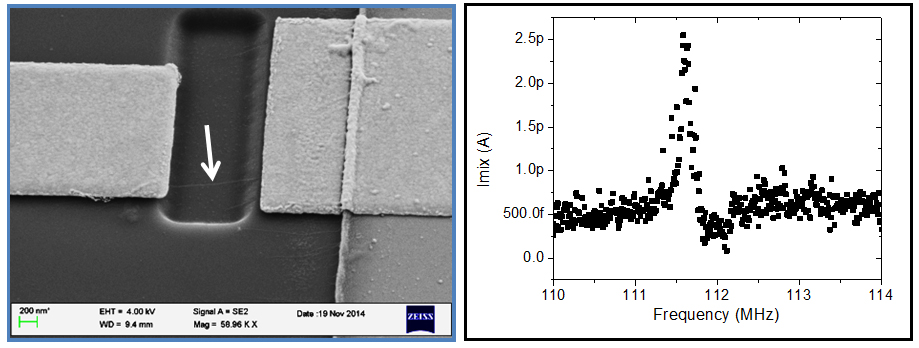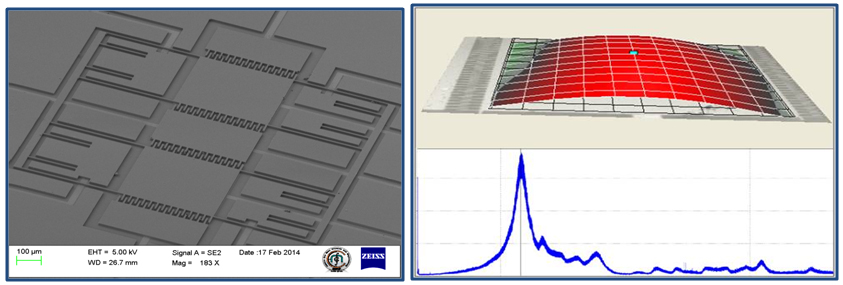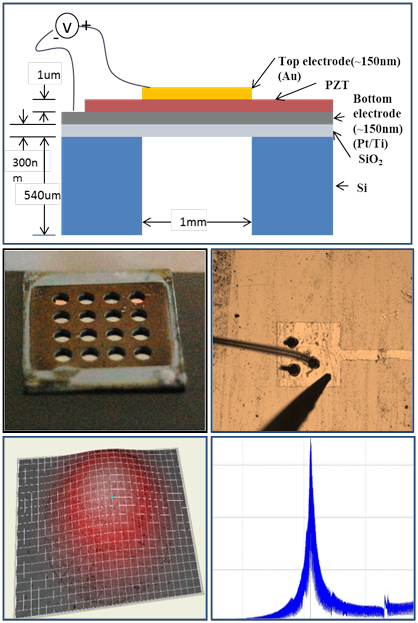MEMS/NEMS devices are sensitive to a wide range of stimuli such as temperature, mass, pressure and are thus extensively used as sensors in cars and mobile phones. The biggest promise of MEMS and NEMS technology is the development of extremely small sensor systems that can be used virtually everywhere and thus can impart intelligence to almost all man-made things.

Fig. 1 : a) Suspended single walled carbon nanotube (SWCNT) NEMS fabricated at CeNSE. The diameter of the nanotube is ~1.5nm b) Electromechanical response of the Mechanical Resonance of the SWCNT device.
NEMS sensors for mass spectrometry applications: NEMS devices due to the small size are extremely sensitive to changes in its properties. This property has recently been utilized to demonstrate mass spectrometry on biomolecules using extremely sensitive NEMS devices. As part of the sensors area in Prof. Akshay Naik‘s group, NEMS devices made of carbon nanotubes are being used as extremely sensitive mass sensors to measure mass of individual protein molecules. Research emphasis in this area includes the fabrication of suspended single walled carbon nanotubes and development of an ultra-high vacuum system for performing mass spectrometry.

Fig. 2 Dynamic Characterization of MEMS Gyroscope

Fig. 3 PMUTS for acoustic and ultrasonics applications
MEMS/NEMS sensors for dynamic applications: Prof. Rudra Pratap‘s group designs and develops dynamic MEMS and NEMS devices with applications in inertial sensing (MEMS gyros, mass detectors), acoustics (MEMS and NEMS microphones), and ultrasonics (capacitive and piezo transducers, also known as CMUTs and PMUTs). The focus is on exploiting transduction mechanisms that are favourable at these small scales and designing low power and high sensitivity sensors that can impart intelligence to manmade objects. All the sensors that are designed and developed use extremely small structures that oscillate in response to some mechanical stimulus. Such structures necessarily require elastic and inertial elements that are suspended over a substrate with appropriate clearances to enable oscillations. The dimensions involved and the compatibility of the fabrication process with CMOS make it ideal to combine these structures with electronic devices such as FETs. They are working on Suspended Gate FETs where the gate is a micromechanical structure capable of responding to a mechanical stimulus and causing a substantial change in the drain current of the transistor. This work is a collaborative effort by Prof. Navakanta Bhat and Prof. Rudra Pratap‘s group, and the goal is to develop a platform technology for extremely sensitive dynamic displacement and pressure sensing.
|
Professor |
Professor |
Associate Professor |
Assistant Professor |
|
Visiting Professor |
Professor |